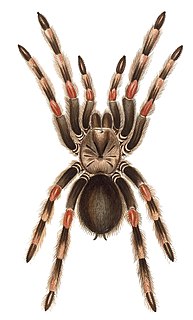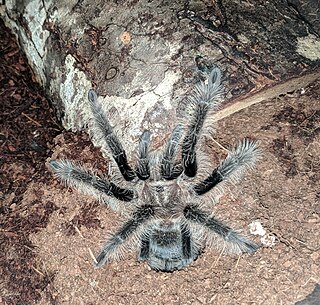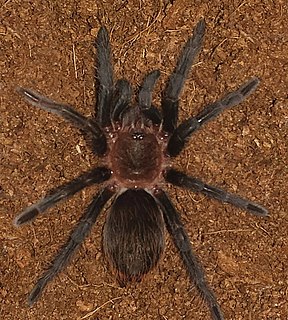
Brachypelma is a genus of spiders in the family Theraphosidae (tarantulas). They may have bodies up to 6 cm long with legs of similar or greater lengths. Some species have brightly colored legs, with red or orange marks and rings.

Brachypelma hamorii is a species of tarantula found in Mexico. It has been confused with B. smithi; both have been called Mexican redknee tarantulas. Many earlier sources referring to B. smithi either do not distinguish between the two species or relate to B. hamorii. B. hamorii is a terrestrial tarantula native to the western faces of the Sierra Madre Occidental and Sierra Madre del Sur mountain ranges in the Mexican states of Colima, Jalisco, and Michoacán. The species is a large spider, adult females having a total body length over 50 mm (2 in) and males having legs up to 75 mm (3 in) long. Mexican redknee tarantulas are a popular choice for enthusiasts. Like most tarantulas, it has a long lifespan.

Brachypelma smithi is a species of spider in the family Theraphosidae (tarantulas) native to Mexico. It has been confused with Brachypelma hamorii; both have been called Mexican redknee tarantulas. Mexican redknee tarantulas are a popular choice as pets among tarantula keepers. Many earlier sources referring to B. smithi either relate to B. hamorii or do not distinguish between the two species. B. smithi is a terrestrial tarantula native to Pacific coast of the Mexican state of Guerrero.

Tliltocatl vagans is a species of tarantula known commonly as the Mexican red rump. It ranges predominantly in Mexico, but is also found in Central America. They are terrestrial, burrowing spiders. The reason for the name red rump is because of its distinctive red hairs on its abdomen. Like most tarantulas, they will eat anything they can overpower, which is usually insects, but small lizards and rodents may also be consumed. They can grow up to a solid 6.5 inch leg span, with males typically being smaller and thinner than the females. They prefer shrubland habitats.

Phormictopus is a genus of spiders in the family Theraphosidae (tarantulas) that occurs in the West Indies, mainly Cuba and Hispaniola, with three species probably misplaced in this genus found in Brazil and Argentina.

Tliltocatl albopilosus is a species of tarantula, also known as the curlyhair tarantula. The species' native range is Nicaragua and Costa Rica. They are largely terrestrial, opportunistically burrowing spiders.

Brachypelma boehmei is a tarantula native to Mexico in Guerrero state. These long-lived tarantulas prefer burrowing and hiding in dry scrubland. As with all closely related tarantula species, they defend themselves with urticating hair when provoked.

Tarantulas comprise a group of large and often hairy spiders of the family Theraphosidae. Currently, 1039 species have been identified, with 156 genera. The term "tarantula" is usually used to describe members of the family Theraphosidae, although many other members of the same infraorder (Mygalomorphae) are commonly referred to as "tarantulas" or "false tarantulas". Some of the more common species have become popular in the exotic pet trade. Many New World species kept as pets have setae known as urticating hairs that can cause irritation to the skin, and in extreme cases, cause damage to the eyes.

The Mexican redleg or red-legged tarantula is a species of terrestrial tarantula closely related to the famous Mexican redknee tarantula. Like the redknee it is a docile tarantula and popular in the pet trade. It is slow growing and, like many tarantulas, females can live for decades.

Brachypelma albiceps is a species of spider in the tarantula family, Theraphosidae. It is known as the Mexican golden red rump tarantula or the Amula red rump tarantula. The carapace is a light golden color and the abdomen dark, covered with long red hairs. Females typically live for about 15 years. Males usually live about 5 years or up to 12 months after the last molt.

Aphonopelma marxi is a species of spider in the family Theraphosidae (tarantulas), found in United States. Aphonopelma behlei and A. vogelae, at one time considered separate species, are now considered to be synonyms.

Sericopelma is a genus of tarantula, found in Central America from Nicaragua to Panama. The limits of the genus and its distribution have long been confused; it is closely related to the genus Aphonopelma. Sericopelma species are among the largest found in Central America. They can be kept as pets, although at least one species has been described as "very aggressive".
Tliltocatl andrewi is a possible species of spider in the family Theraphosidae (tarantulas). The World Spider Catalog regards it as a nomen dubium. Only the male has been described and its distribution is unknown.
Tliltocatl aureoceps is a possible species of spider in the family Theraphosidae (tarantulas). The World Spider Catalog regards it as a nomen dubium. Only one female has been described; this was captured in the Florida Keys, but is likely to have been imported from Mexico.

Tliltocatl epicureanus is a species of spider in the family Theraphosidae (tarantulas), found in the Yucatán Peninsula of Mexico.
Sandinista lanceolatum is a species of spider in the family Theraphosidae (tarantulas), native to Nicaragua and Costa Rica.

Tliltocatl kahlenbergi is a species of spider in the family Theraphosidae (tarantulas), found in Mexico.

Tliltocatl sabulosus is a species of spider in the family Theraphosidae (tarantulas), found in Guatemala.

Tliltocatl verdezi is a species of spiders in the family Theraphosidae (tarantulas), found in Mexico.

Tliltocatl is a genus of North American tarantulas that was split off from Brachypelma in 2020. They are also large burrowing tarantulas, but don't have the striking red leg markings of Brachypelma species. A female T. vagans can grow up to 50 mm (2.0 in) long and legs can get as long as 55 mm (2.2 in). They are found predominantly in Mexico, with some species native to Central America. The name is derived from two Nahuatl words, "tlil", meaning "black", and "tocatl", meaning "spider". Habitat destruction and collection for the pet trade has led to this and Brachypelma to be protected under International Convention on International Trade of Endangered Species rules, beginning with B. smithi.


















